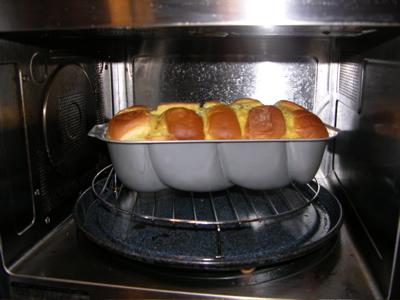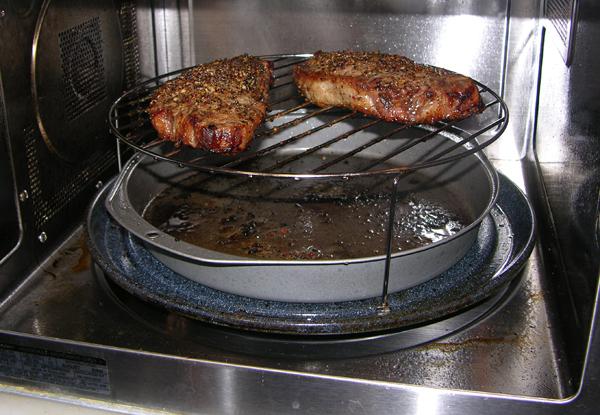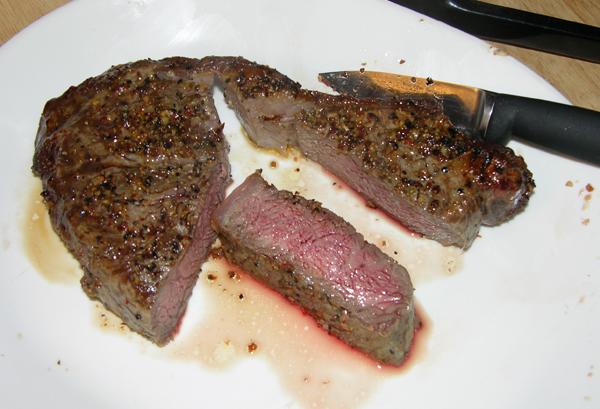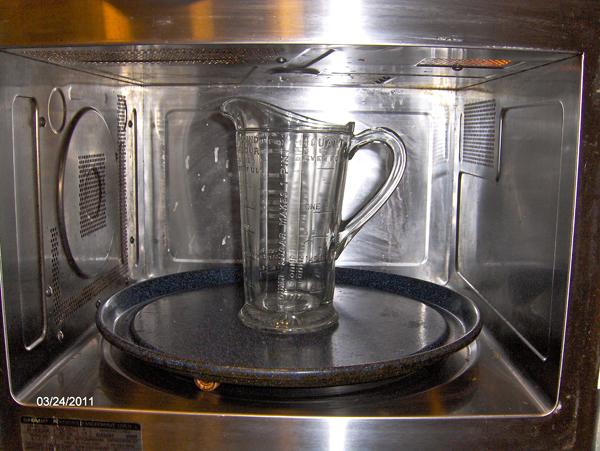-
Posts
11,033 -
Joined
-
Last visited
Content Type
Profiles
Forums
Store
Help Articles
Everything posted by andiesenji
-
I do want saffron from a reliable vendor - some saffron has been blended with dried and dyed calendula petals to extend it, so I buy from trusted vendors. For the past few years I have purchased from Vanilla, Saffron Imports in San Francisco. I'm sure there are other vendors who provide a quality product but I can depend on their product being of very high quality. I just ordered some for Saffron Bread for Easter. (I also ordered some of their dried mushrooms and a can of Cuitlacoche - just because...)
-
I've been using the DLX for quite a few years. I wrote the message that is in the link in 2004. It's still going strong and handles even the stiffest dough. I originally got it for Peter Reinhart's Struan bread dough: Crust & Crumb, 1998. I bought mine from Pleasant Hill Grain They include the dough hook, which some vendors only sell as an extra and shipping is free. They also carry the Bosch Universal which, without the blender, is only $429.00 Friends who do a lot of bread-baking have the earlier version of this mixer which in essentials, has not changed, and the motor is tough. It handles more dough than an KA but has a lower profile than the bowl-lift models. A few years ago this was sold by King Arthur Flour, as was the DLX Magic Mill/Electrolux Assistant. I recommend this vendor because I have purchased several appliances from them (my Nutrimill, for instance) and their customer services is excellent. I purchased the DLX before they had online ordering and their telephone response impressed me. One of the wire beaters was slightly bent and they immediately sent me a replacement and a shipping label so I could return the original in that box and not have to pay any postage.
-
I manage to go through a jar of wheatgerm in about three months or so, sometime more rapidly. I put a couple of tablespoons in almost every batch of bread dough, quick breads - especially in banana nut and pumpkin and it is "fabbo" in carrot cake. (A friend's favorite term.) I add it to yogurt along with other dry cereals, also to smoothies. I add it to casseroles that contain beans, other legumes and grains. I add it to brown rice dishes to "perk" them up a bit and also to soups.
-
I also slow roast them in the oven - I also have pickled them in spicy pickling liquid similar to that I use for my bread & butter pickles. A couple of years ago I found this recipe which is excellent and the cheeses can be seasoned with almost anything you desire. My most recent experiment was stuffing the baby bells with the cheese mixture along with a calamata olive and a large black garlic clove. I used one of the "Italian seasoning" mixtures to flavor the cheese.
-
A few months ago I was invited to a dinner with friends who do know how to cook and usually present a very acceptable menu. That time they had gotten an incredibly expensive (or so they said) New Zealand leg of lamb. "flash frozen, cryopak" . Now I have to say that I am not a big fan of lamb at the best of times, and I do like it well done. When carved, the lamb was nicely browned on the outside but the inside was completely raw and cold - I think it had not been fully defrosted before going into the oven and next to the bone it looked like it was still chilled. I couldn't eat it and while the host and another man tucked in, none of the women and one of the men ate the sides and avoided the lamb. I asked the woman if she had checked it with a probe thermometer (which I know she has) but she said, no, she had been preparing lamb in this manner "forever" and had no idea what had gone wrong. I commiserated with her and suggested she have her oven calibrated and use the probe thermometer in the future. I also suggested she cut the meat off the bone and prepare a lamb stew.
-
Is this something you envision? Or this? A friend's son, who recently graduated from Northwestern, recently started working for this company as a traveling rep. They are placing them in upscale malls, colleges, large game arcades and etc., possibly hospitals. They are in what must be considered a "niche" market so as yet do not have wide distribution but folks, such as my friend, are spreading the word to people who might be interested. (She worked in the hospitality/hotel industry for thirty years so has a lot of contacts.) I have to confess that I printed out the info from the web page and gave it to one of my local friends who works in management at the local mall. They do have a food court but it is a long, long trek from one end of the mall to there and on weekends, when the multiplex theater - across from the food court, is going full tilt, it is time consuming to stand in line and then find a table. They do have a few "basic" vending machines but I thought this would be a great addition.
-
You can't always predict how any one piece of meat is going to behave when compared with another. I have roasted two, identical weight and appearance - PRIME grade - standing rib roasts in the same oven (but in two different pans) and had one reach the internal temp I wanted, 40 minutes before the other one. The internal structure or density of the meat can vary considerably and this also determines how the end product is going to appear and taste. The two roasts were fine, as it was the longer time that I expected. The one that was done first was an exception to the rule. When cut, it had significantly more marbeling inside, something that was not apparent on the surface. The guests (it was a catering even) loved both roasts and there was plenty of every type of doneness to satisfy everyone. Nothing but compliments (and a big tip from the client). I've been cooking for 60 years and I can't think of any way short of taking a core sample to determine what the inside of a solid roast is like. I've had higher temps show up because the temp probe hit a fat pocket where the temp was higher than in the surrounding meat so it is important to test in more than one spot.
-
wow...just received my order of this aged sherry vinegar. to my palate, it is harsher than the don bruno. i think i have some manchego in the cheese case, so i'm gonna try that pairing, but the initial taste is pretty rough! That has been my experience with some of them. As I noted above, I added some sweet sherry (Savory & James cream sherry) and left it alone for a month or so. Improved it no end. I mixed two parts of the sherry vinegar with one part sweet sherry.
-
I tried it once (my kids seemed to have a severe problem with controlling bubble gum) but the resulting mess was also a pain to clean. I then began using Avon's Skin-So-Soft bath oil. Much easier to apply and to clean up. I use cornstarch to take grease out of the carpet and to "extract" residual spilled liquids from carpet after the use of a wet/dry vac. If you have only one spice grinder - and use it for coffee or other oily material - you can clean and deodorize it with the following procedure. Put three tablespoons or so of baking soda in the spice grinder. Add 4 or 5 broken saltine crackers - you can also use rice. Put the lid on and start the grinder - invert it (holding the top on firmly) several times. Dump out the stuff, wipe it with a dry paper towel and check. If you have used it for a long time for grinding coffee beans, you may have to repeat this procedure but it will clean the grinder without using water and will remove all traces of the oils that tend to build up around the base of the grinder blades. I used this method for years before I decided that since these grinders were so small and so cheap, I could have dedicated ones for each type of product.
-
If it doesn't work out, check out the Sharp, like the one I have but in white, for less than $400.00
-
Those are just beautiful, Linda. Mazeltov!
-
In the early '60s, when I lived in Glendale, one of the gardeners who worked for the city, nearly died after spilling Black Leaf 40 on his pants and shoes and not removing them and washing immediately. He was hospitalized for a long time and was not able to return to his job because of severe palsy. It was surmised that if he had not received treatment when he did, he would have died. That was before the days of 911 and people with emergencies had to get to ERs on their own or with help from ordinary citizens. I don't remember when this insecticide was taken off the market but it was available for years after that episode. Rose growers loved it because it was a very effective bug killer. I grew up on a farm where tobacco was grown and while us kids were allowed to help in the drying barns, we were warned to not get any of the sap on our skin and if we did, wash with soap right away.
-
I would't think so. The flavor difference between regular and cultured butter is pretty subtle. And in the quantity used, I'd think there'd be very little difference. But I have been considering adding culture directly to a starter. I was actually thinking because the cultured butter would contain extra lactobacilli not from direct flavor contribution. To encourage a bit more "sourness" in my sourdoughs, I use whey from yogurt and cream cheese making and also the liquid left over from making cultured buttermilk, which is somewhat like yogurt whey but with less milk solids (they are incorporated in the butter). I simply freeze the extra whey until I am ready to use it. You can buy a powdered whey at health food stores (not the "sweet dairy whey" sold by King Arthur and others) or you can use buttermilk or even the powdered buttermilk mentioned on another thread. If you have a fat separator, you can pour the buttermilk into it and leave it to "settle" (or actually rise) and after the milk solids have risen to the top, drain the clearish liquid from the bottom - it is very tangy and perfect for giving a bit of "oomph" to sourdoughs and also to rye breads.
-
During the past couple of years I have been using coconut oil in some breads as a sub for butter, lard or oil. I do not use margarine at all. I won't use it again in brioche - nothing works as well as butter. The brioche made with coconut oil had a rather tough crust, not near as tender as with butter. It worked very well in whole grain with nuts and seeds breads, black bread, rye bread and sourdoughs where I did NOT want a very thick, crisp crust. I get a better artisan-type crust, thicker and crisper, with no fat at all. I don't use any fat in my French bread. In quick breads I substituted coconut oil for lard in biscuits and scones with excellent results. Not so much in pie crust. It was okay but not nearly as tender as with lard. I used coconut oil and butter half and half in shortbread and it turned out quite nice.
-
While looking for something else, I came across this product on Amazon, of all places! A friend who is not on the internet asked me to find "hookah molasses" - a product that was totally unfamiliar to me prior to this. It is inexpensive so an experiment should not be that costly.
-
If it is this model, use caution. My best friend got one to replace a built-in older Panasonic convec/mwave oven (one in which the turntable had to be removed to use it as a convection and combi oven and the food had to be rotated at least once) that had worked for several years. Only after purchase did they learn that it could not be placed in the spot for the built-in unit but they decided to try it anyway. Within a few weeks the door interlock failed with the door closed, they couldn't get the door open and had to call a technician. Then the motor that rotated the turntable began to work erratically. They were able to return it to the seller and got the Fisher & Paykel because the dealer did not carry Sharp. The F&P could be built in and there is an accessory kit to finish it. It works fine but cost more than twice as much as the Sharp for essentially the same features. You can get the Panasonic NNCD9895 for less at this vendor. P.S. The "inverter" is not all that efficient. If you are going to spend 700. you might as well spring for a bit more and get Sharp's newest: The SuperSteam combi oven It can be built in or used on a countertop. If I did not already have the extra Sharp, I would get this one. I love steam cooking.
-
I had to check my memory with the help of the world wide wikipedia. Kerr's The Galloping Gourmet went from '69 to '71. That correlates well with my memory of watching him in the early afternoons in the midwest at the age of 7 or 8. It is true that the original 400+ episodes were filmed and broadcast live between '69 and '71 (when he was injured in an auto accident and was unable to work) but these were syndicated shows and were rebroadcast by many local TV stations(channel 13 in the L.A. Area) from the mid-'70s to late '80s and he had another show (with more heart-healthy cooking) for one season in the late '80s or early '90s. Food TV network also broadcast some of those early shows in the early days when they did not have a lot of programming, often late at night. (I'm 72, as of yesterday, and so far my memory for those "olden days" is pretty good.)
-
The fan is less forceful than in my Cadco convection oven. I use the Sharp for baking cheesecakes and custard pies, etc., that tend to develop ripples on the surface when baked in the Cadco - unless I use some kind of barrier. The turntable also moves smoothly - in some microwaves the motion is rather jerky and this too would affect custards, etc., the turntable base is also wide enough to prevent tipping if something heavy is near an edge and it's metal, not flimsy plastic.
-
In Van Nuys, CA, not far from the 99 Ranch Market, there is a Soba noodle restaurant/shop where they sell soba noodles to take home or in containers with a broth for immediate consumption. I was taken there by a friend when we were down in the valley doing some shopping at Star Restaurant supply, at 99 Ranch and at a meat market also on Sepulveda Blvd., so I don't really remember the exact location. All I can say is that you get a lot of noodles for not much money. I left nose prints on the glass barrier where the noodle maker was performing his "show" and it was worth the cost to see how he did it. At one point I really thought he had more than two hands as I couldn't begin to see how he could handle that huge bundle of noodles with just two!
-

New products from Rancho Gordo (banana vinegar and more)
andiesenji replied to a topic in Kitchen Consumer
My neighbor uses the sugar for making candies - also candied pumpkin and squash and some fruit candies. Sometimes it is very hard, if stored for a long time and she uses the same thing I use on jaggery, a coarse carpenter's rasp. Works a treat with less effort than hammering the stuff and pounding it in a mortar. -
Back to the kitchen? To the library? Out for a bike ride? Watch less tv and do stuff? Read internet forums? Cooking shows were created for housewives who were home in the afternoon (before there was cable and VCRs) and were expected to cook. It's not too surprising that there are fewer of those shows as that demographic shrinks relative to the overall population. Now we have cable and DVRs and DVDs and video on demand and everything else: we can watch whatever we want, whenever we want. Everyone wants speed, convenience, entertainment, and vicarious thrills. It's on commercial tv, so it's driven by ads, which mostly means processed foods and family restaurants. They're not going to promote shows that say those things aren't needed. They want you to believe that cooking is best left to professionals and people in places you might never visit. I can't agree with the entirety of this premise. There were not that many cooking shows being broadcast when the majority of married women were still home during the day. In the late '70s and '80s there were just a couple broadcast during the day - in my area Graham Kerr was broadcast at 5:30 p.m. The Frugal Gourmet was broadcast in the early afternoon and again in the evening, I think it was 9:30 p.m. Most of the women in my neighborhood worked outside the home at least part of the day, most had full time jobs. In southern California, the turning point was in the early '70s when inflation made it imperative for families to have more than just one income to keep even. Housing prices were already beginning to shoot up and by the end of the decade had doubled. In the '80s the aerospace industry pretty much took a dive and all those well-paid engineers were out of work. Women had to work outside the home. I welcomed the appearance of FoodTV Network. I loved Curtis Aikens and especially John Ash. They spoke intelligently and did not give the impression that their viewers were incapable of understanding adult conversation. I resent being "talked down to" by food show presenters and that has been my complaint with the more recent Food TV shows. I like the PBS shows, they aren't trying to sell me something and they don't present it as if they are teaching a bunch of morons.
-
Here are some photos with it in use for baking and broiling: A large (2-pound) loaf pan and the results of the latter The two racks can both be in use at the same time and I have baked two pies at the same time, one on the upper rack and one on the lower - in Pyrex pie plates.
-
I have the Sharp R930AK Convection/Microwave oven, 1.5 cu.ft. that I purchased in 1994 and it is still working just fine. I like it especially for roasting meats and poultry that are "stuffed" because with the "combi" roasting feature it cooks them evenly and more rapidly than in a conventional oven. It doesn't cost much more than one of the more expensive microwaves and it has one super advantage in that the interior is TALLER than other mwaves of similar capacity. This glass measure is 8 3/4 inches tall and as you can see it has plenty of clearance. And the bottom tray is 15" in diameter and will hold fairly large baking dishes and it will also hold a round pizza "stone" for baking. The well around the circumference of the tray is deep enough that it will catch any liquids that boil over or otherwise spill. This is a BIG advantage over most microwaves. It is also very easy to clean. This site has the specs and info: I was afraid they were going to discontinue this unit and I don't like those made by other manufacturers so I purchased an "extra" still in its unopened box, for when this one dies. However, so far it has been virtually indestructible. People with similar ezperiences to mine have posted here
-
I have yet to come across real stone-ground hominy grits that cook to perfection in twenty-five minutes. I've been cooking grits for sixty+ years.
-
I often buy things that are sampled at Trader Joe's because that store has rarely disappointed me. Many of the items have been things that I would not have purchased just seeing the package. Being able to see the actual product and tasting it, showed me that it was easy to prepare and tasty.





